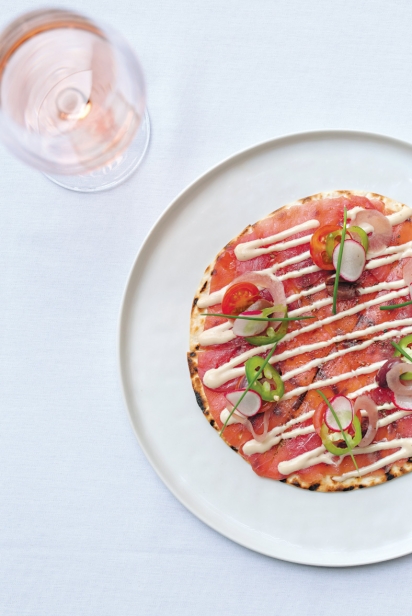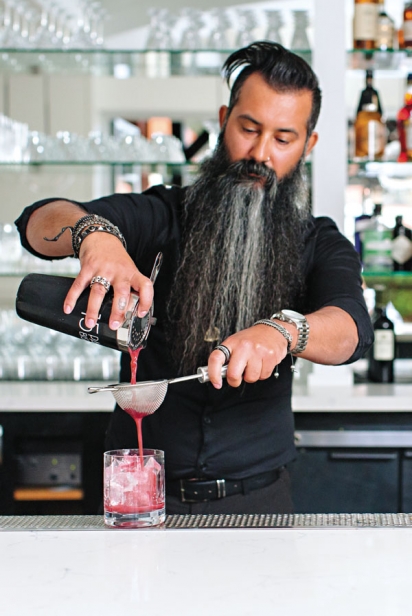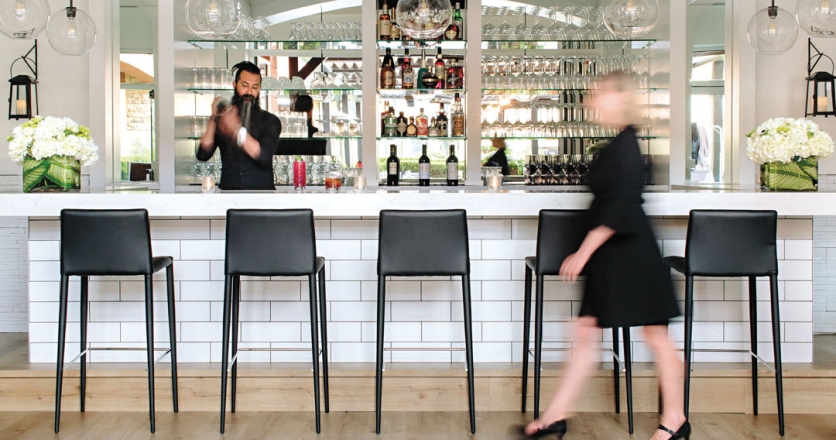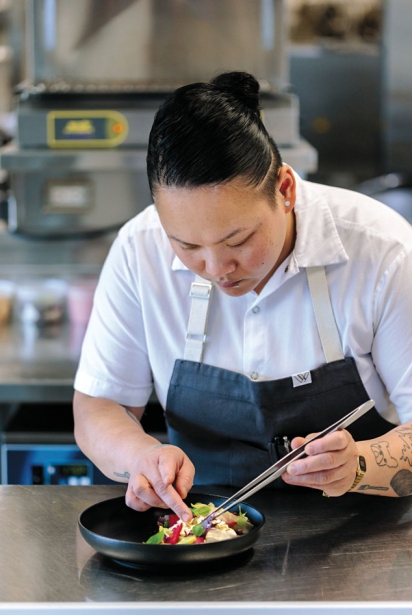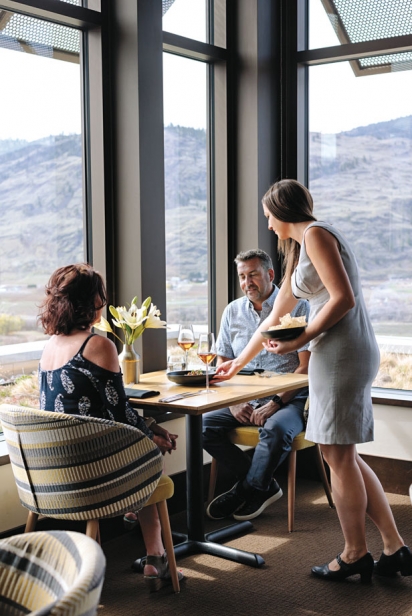Sun, Soil and Shortages
This was going to be a very different type of story. It was going to be a lyrical essay about all the talented chefs who are moving to the South Okanagan Valley, drawn by the incredible bounty of local ingredients. It was going to be about food that tastes joyfully of the sun and the soil and the sage-scented air, and why wine country is the place you should be this summer, tasting all the delicious things and drinking in the sheer joy of being alive.
All of that is still true, of course. But it’s not the whole story.
As I was planning my trip, my departure was pushed back, again and again, because so many restaurants and wineries kept delaying their opening dates. I finally left Vancouver on a Friday, planning to dine that night at a new pasta place in Oliver that my friends had raved about. I arrived five hours later to find a note on the door and hungry people standing around forlornly — the owner had suddenly decided to close, with the intention of reopening mid-week for lunch only. Another restaurant I visited closed right after I got home, with no re-opening date in sight. Still others were posting limited hours, even as the busy summer season began.
There are plenty of reasons wine country is struggling right now. There’s a shortage of glass for bottles and printer’s ink for labels. The price of everything, from the pasture-raised beef on your plate to the fuel for the vineyard tractor, has soared. Grape yields were down about 30 per cent last year. The year before, sales plummeted because the pandemic closed so many restaurants. In summer, heat, wildfires and smoke kept tourists away; in fall, floods washed out several highways, keeping everyone else away too.
But difficult as those challenges have been, the real problem is that there are simply not enough people. Not enough cooks, not enough servers, not enough dishwashers, drivers, tasting room staff, farmworkers or grape pickers.
So while the South Okanagan is one of the best places in the world to dine, you might have a tough time getting a seat at the table.
High ambitions at Phantom Creek
From my perch at The Restaurant at Phantom Creek, I can see all the way to Osoyoos Lake, shimmering blue in the distance. Below, rows of vines unfold neatly toward Black Sage Road, embraced by sand-coloured bluffs to the east and the greener slopes of the Golden Mile Bench to the west. Dappled light shifts over the landscape as clouds drift lazily overhead, a soaring kestrel crying shrilly as it searches for prey.
This is perhaps the primest of prime locations in the South Okanagan Valley, which officially begins at the giant rocky ridge known as McIntyre Bluff and stretches to the desert town of Osoyoos. Some 10,000 years ago, during the last ice age, the bluff was the site of a massive ice dam that formed the boundary of Glacial Lake Penticton. When the dam burst, the area to the south was flooded with the sand, silt and other glacial debris that still forms much of the soil around Oliver and Osoyoos.
That includes the historic, award-winning Becker and Phantom Creek vineyards where this winery sits. Its owner, businessman Richter Bai, has spared no expense in creating the grandest facility in the south. Phantom Creek Estates features an amphitheatre, a towering angelic statue to welcome guests, a private tasting room with its own Dale Chihuly chandelier, and two of the world’s most renowned winemakers leading its team, Napa’s Mark Beringer and Alsace’s Olivier Humbrecht.
So it’s little wonder that its restaurant was the most highly anticipated and hotly discussed opening in the entire valley last year.
Leading this lofty endeavor is the soft-spoken and profoundly skilled young chef Alessa Valdez. Originally from Toronto, where she worked at such A-listed restaurants as Buca Yorkville, Alobar and Canoe, Valdez was drawn to the Okanagan by its incredible bounty. She has worked hard to build relationships with local farmers, painstakingly selecting only the best, freshest ingredients for a menu that takes familiar dishes and transforms them into something exciting and new. (She also has a kitchen garden of her own, if she can protect it from the region’s hungry wild horses.)
Take the beef tartare, made with hand-cut 63 Acres beef and garnished with her own housemade XO yolk caramel, pickled shimeji mushrooms, mushroom dust and crispy chips made from puffed tendon in a three-day process she calls “a labour of love.” Or the halibut, served with an umami-rich dashi broth and fresh peas, favas and watercress, best enjoyed with the stone- fruit notes of the 2020 Similkameen Small Lot Chardonnay.
And who would think a simple pavlova would be something to get excited about? It is when it features preserved apricots and housemade granola, and is saved from cloying sweetness by pink peppercorns and Thai basil.
This is some of the most beautiful and ambitious food in the valley, served in a pleasantly intimate dining room, with spectacular, sweeping valley views. It is a must-visit destination for anyone who loves fine food and wine.
But don’t expect to go for dinner, because it likely won’t be open. And if you plan to go for lunch, make your reservation well in advance. Even a restaurant as well funded as this, with a chef as well-respected as Valdez, is struggling to find cooks and servers.
They’re not coming back
Valdez isn’t alone, of course. Every business is struggling with staffing these days. But the hospitality industry has been especially hard hit, and even more so in smaller communities that rely on seasonal revenue.
When the pandemic closed restaurants in 2020, cooks, servers, hosts, sommeliers and dishwashers were laid off en masse. Some spent their time off taking stock and decided they no longer wanted to work in a poorly paid, sometimes abusive industry with unpredictable hours and few benefits. Others decided they could no longer afford the insecurity of a job that could shut down at any moment.
The thing is, as one Vancouver chef told me, “They are just not coming back.” He’s had to raise wages to staff his kitchen, paying more for less-experienced cooks working fewer hours. “I’m now paying my line cooks what I used to pay my sous,” he says, and added wistfully that he wished he could have offered his old team this kind of money.
But at least in the city, there is a pool of talent to draw from, even if it isn’t very deep right now. In smaller, seasonally driven communities, there are even fewer people available, especially for a restaurant trying to attract talent at a high professional level.
Shortly after I returned from the South Okanagan, B.C.’s food and wine world gathered for the Vancouver International Wine Festival. VIWF was the last major event of 2020 before the pandemic shut down the world, so there were plenty of hugs and tears and catching up. But amidst the bittersweet reunions, talk of the staffing shortage was a recurring refrain.
When I asked a friend who owns a winery if he would be opening a tasting room any time soon, he said no, simply because he couldn’t find anyone to work it. “There just aren’t any people,” he said
In addition to everything else, there is a shortage of seasonal workers. Farm workers from Mexico are still arriving to work the vineyards, even if their numbers are smaller than before. But most years they are joined by young people travelling from Quebec, Ireland and Australia seeking a few months of work in tasting rooms, restaurants and hotels.
They were kept home the last couple of years by COVID travel restrictions. But even if they showed up now, they would be faced with the high cost of food, fuel and transportation — there is, after all, no Skytrain to the wineries — and most importantly, they wouldn’t have anywhere to live. What little rental market is available in Oliver and Osoyoos tends to be snapped up by tourists, with little left for a server on a budget.
As my friend said, “There’s not much point in taking a job that pays $20 an hour if your accommodation is $2,500 a month.
A destination to savour
Dire as this sounds, the South Okanagan is still an extraordinary place to dine. Talented chefs have slowly been moving here over the last decade or so, tempted by the sun-kissed produce, the slower pace and the sheer beauty of the place. They have connected with local farmers and foragers, and they have transformed the dining scene.
Among the first to arrive was Jeff Van Geest, formerly of Vancouver’s Aurora Bistro and Diva at the Met. In 2010, he and culinary legend Manuel Ferreira opened Miradoro at Tinhorn Creek Winery on the Golden Mile Bench. An early proponent of farm-to-table dining, chef Van Geest continues to champion the finest local ingredients in his wood-fired pizzas, flavourful pastas and other Mediterranean-inspired dishes.
Next door, Terrafina at Hester Creek Winery is now in the hands of chef Adair Scott, who is crafting richly bold dishes to match the winery’s powerhouse wines. He honed his skills at some of Australia’s finest restaurants, but has been a long-time resident of the Okanagan, and is a passionate champion of its fresh, healthy regional cuisine.
Across the valley, at Burrowing Owl Estate’s Sonora Room, just down the road from Phantom Creek, chef Lee Humphries prepares the classically elegant, locally sourced fare that pairs so beautifully with the winery’s lush whites and rich, velvety reds. Originally from the UK, where he cooked through the ranks at Mayfair’s posh Westbury Hotel, he spent 15 years at some of Vancouver’s top restaurants before finding his home at the Sonora Room in 2015.
From here, it’s just another 20 minutes further south on Highway 97 to the border town of Osoyoos. This is true desert country, home to Canada’s warmest lake, and long a popular summer sun destination surrounded by wineries producing big, bold, sun-drenched wines.
It’s here that you will find chef Murray McDonald, who moved across the country from Newfoundland’s famed Fogo Island Inn to lead the kitchen at The Bear, The Fish, The Root & The Berry, the Indigenous-inspired restaurant at Spirit Ridge. It’s named for the four food chiefs of the Syilx People of the Okanagan Nation and celebrates the foodstuffs that have grown here for millennia.
And right downtown in Osoyoos, 15 Park Bistro, the revamped restaurant at the Watermark Beach Resort, has become the place to go for wine and snacks and maybe something a bit more. A really smart makeover has transformed a dark, cramped dining room into a coolly chic space where executive chef Nick Atkins serves up a menu perfectly designed for grazing. Expect lots of bright salads and share plates, a lobster bar for those who like to indulge (and who doesn’t?), as well as burgers, steaks and healthful bowls, best enjoyed with consulting sommelier Ron Rocher’s thrilling selection of local and international wines.
All of these chefs are cooking terrific food that celebrates the work of local producers and winemakers. All of them are doing it at a high level despite the shortage of workers in both front and back of house. To survive, they might have to reduce their menu items or their hours. They may not have as many seats available.
They might take a little longer to prepare your food. And their servers might take just a little longer to get it to your table.
This is where you come in.
If you are planning a trip to the South Okanagan, you should definitely still go. It is one of the most beautiful places on the planet, with an incredible food and drink scene, and some of the kindest, most gracious hospitality too. But be prepared for things to be a little different this summer.
So book ahead where you can. Expect reservations to fill up fast. Expect to wait longer, and to pay more. Be patient. Be kind. Don’t no-show. Don’t take your frustrations out on your server — it’s not their fault, and they can’t do anything about it anyway. Tip well even when things go wrong.
After all, you are in wine country, where you can taste all the delicious things and drink in the sheer joy of being alive.



